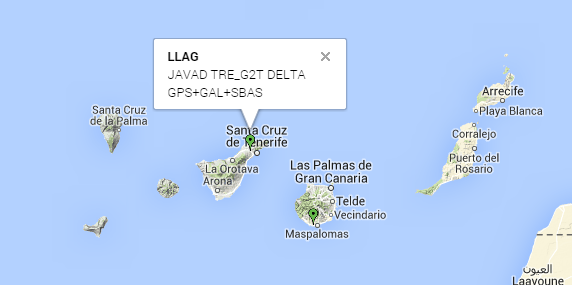First Galileo-only PPP with IOV + FOC-1 satellite
December 11th, 2014 by Guillermo TobíasIt has been over one week now since Galileo FM5 started transmitting. The early results obtained with magicGNSS when processing the data collected by IGS’ MGEX network (http://igs.org/mgex/) during November 29th and 30th were quite preliminar, as they showed what seemed to be corrections being applied to the on-board atomic clock.
The results obtained when processing more recent data (from December 5th to December 9th, as it can be seen in the figure below), show a much more stable clock behaviour for FM5 satellite, which may lead to conclude that the apparent clock corrections have been successfully performed.
Based on this assumption, 2 consecutive 4-day long ODTS arcs have been executed with a 24 hour delay between them, and the overlap for the Galileo satellites, both for the orbit and the clock estimates, has been computed. The results presented below show that the orbit and clock consistency for all the Galileo satellites (both the IOV and the FM5), are in the same order of magnitude.
Galileo clocks consistency:
Galileo orbit consistency:
Despite the fact that the orbit and clock determination accuracy for FM5 can still be improved given the comparison with respect to the results obtained for the IOV satellites, the estimates can be considered accurate enough for thinking about using them for High Accuracy Positioning purposes.
In this regard, a Galileo-only PPP (3 IOV satellites transmitting in more that one frequency + FM5) has been run for LLAG station using as reference products the aforementioned estimates.
This GPS+Galileo MGEX station is located in the Canary Islands, and during December 6th the 3 usable IOV satellites ( PRNs E11, E12 and E19) and FM5 (PRN E18) satellite were visible over that station for around 2 hours, which allowed the computation of a Galileo-only PPP solution for LLAG station.
The estimated station coordinates were compared with the reference ones, which had been previously computed by means of a 24-hour long batch PPP using IGS reference products. The comparison shows that the Galileo-only PPP solution error is at the centimetric level. However, these results are quite optimistic due to the fact that the PPP estimated a single position based on a 2-hour data batch. In this regard we intend to perform a sequential Galileo-only PPP in order to obtain more realistic results about the positioning performances that could be achieved in a Real-Time environment.
Although this analysis can still be understood as a proof-of-concept, the presented results show the feasibility for using E18 satellite for High Accuracy, which can be considered as great news for the GNSS community!
Let’s hope that FM6 satellite follows the same path as FM5 so that it brings benefit for the GNSS community and in particular for High Accuracy purposes.








